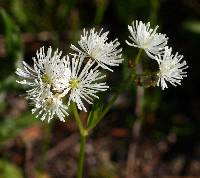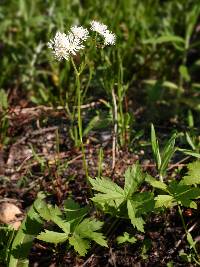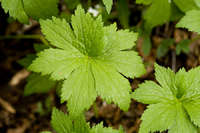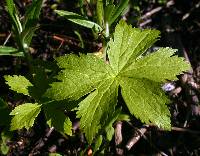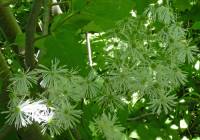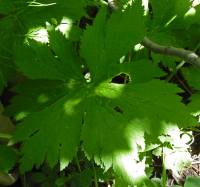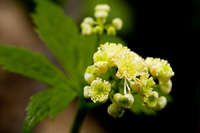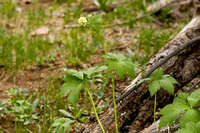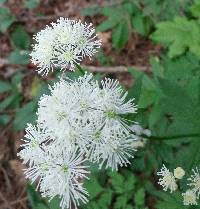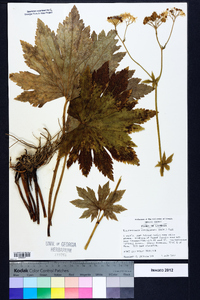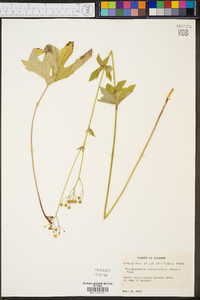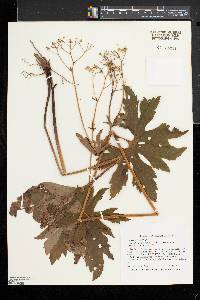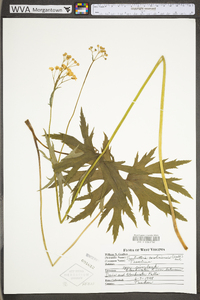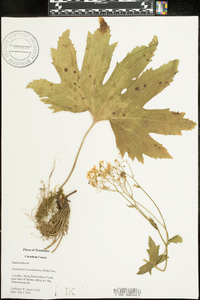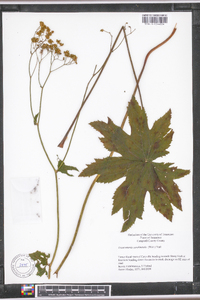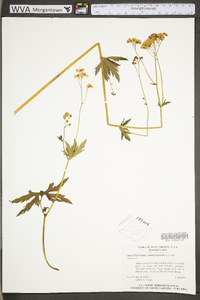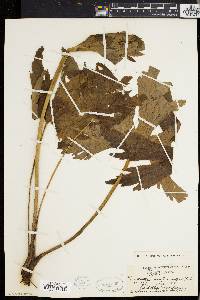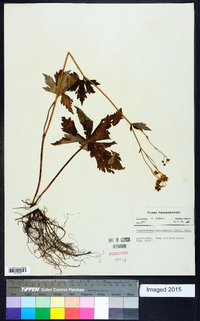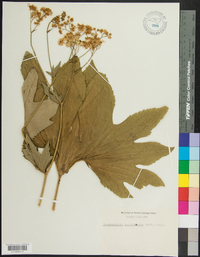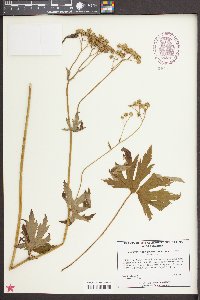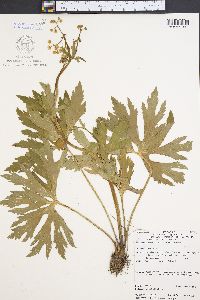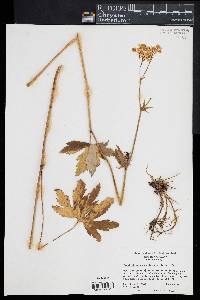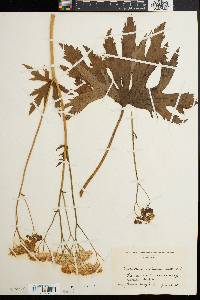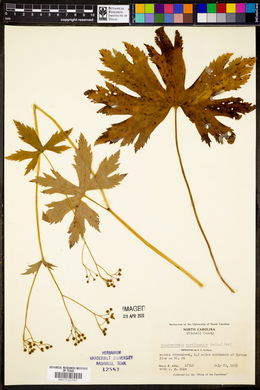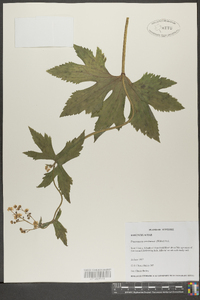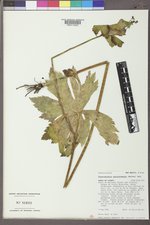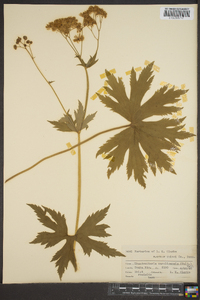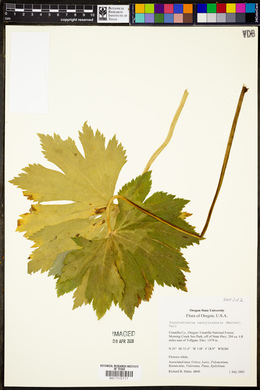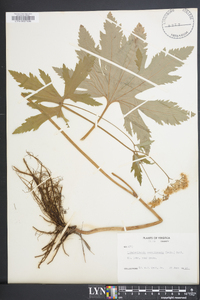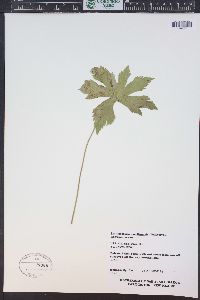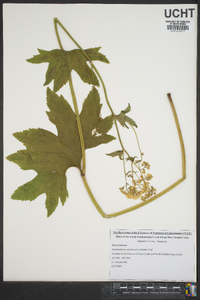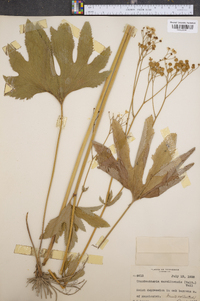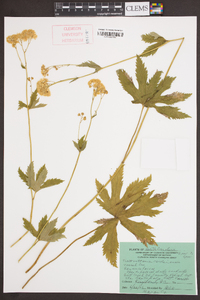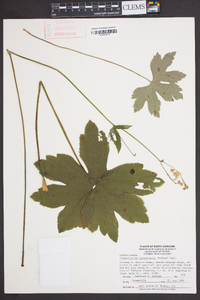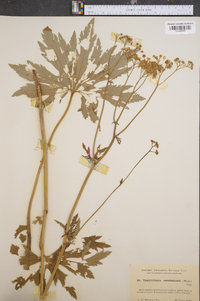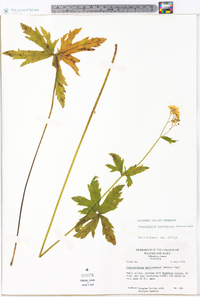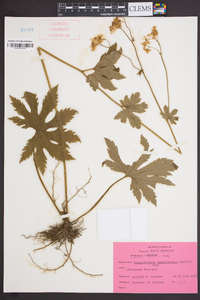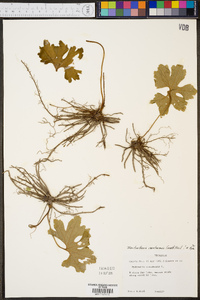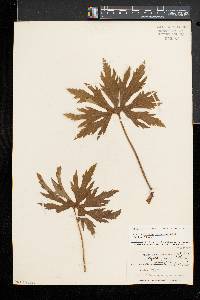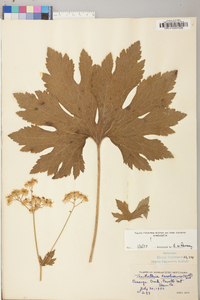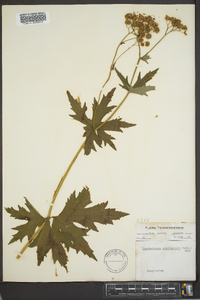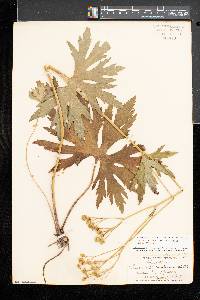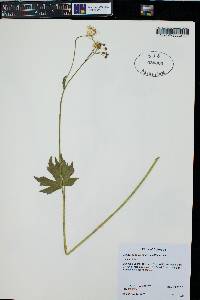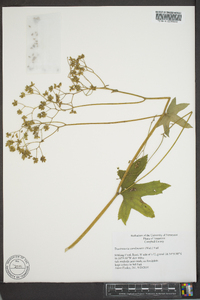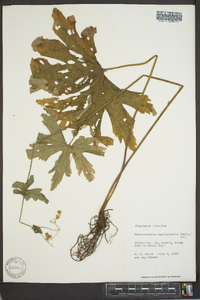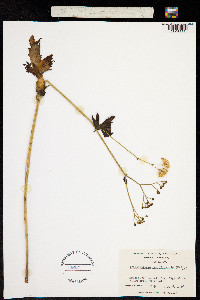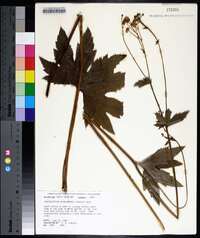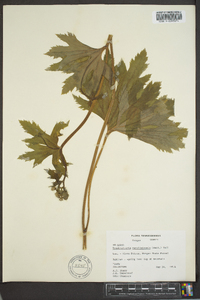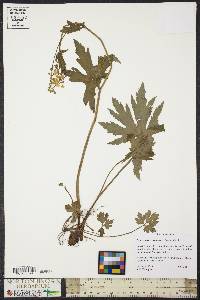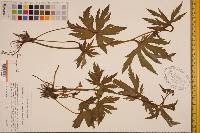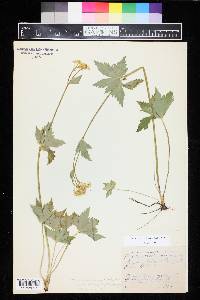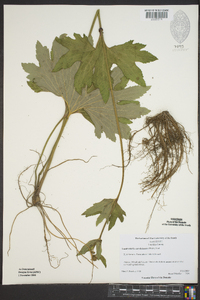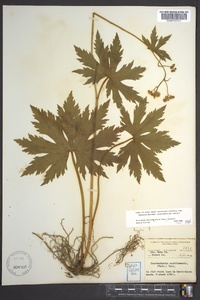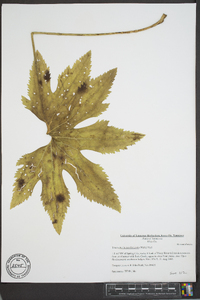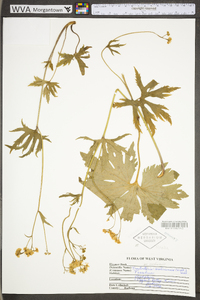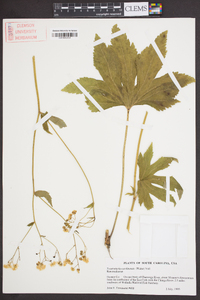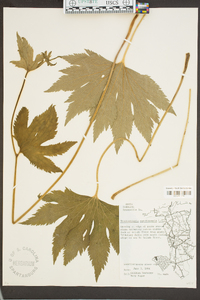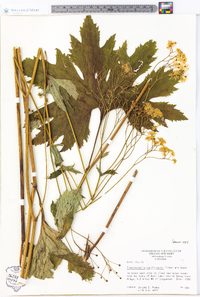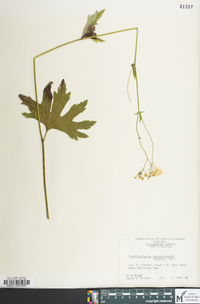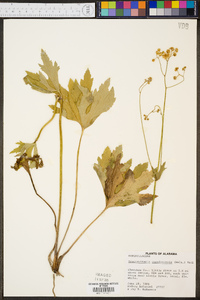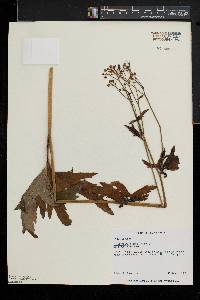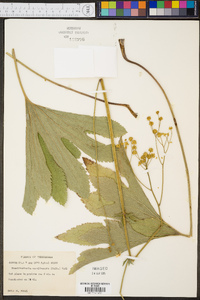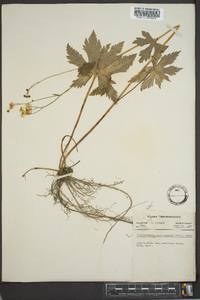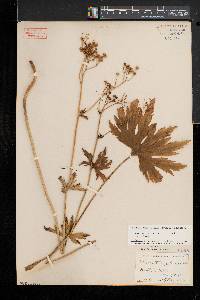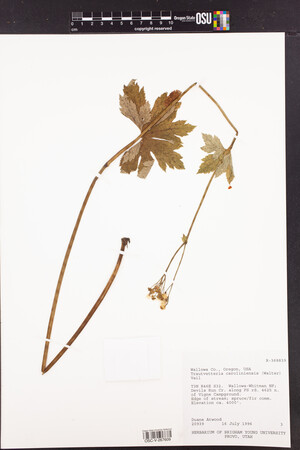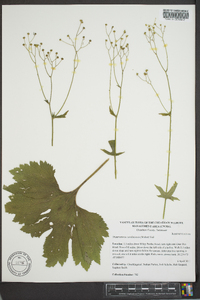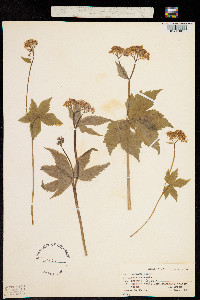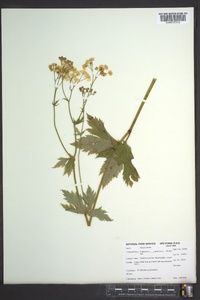
|
|
|
|
Family: Ranunculaceae
Carolina Tassel-Rue, more...Carolina bugbane, falsebugbane
[Hydrastis carolinensis, moreTrautvetteria carolinensis Britton ex A. Murr. & Vail] |
Herbs , 0.5-1.5 m. Rhizome with fascicles of fibrous roots. Stems 1-several, erect, usually unbranched below inflorescence, 0.5-1.5 m, glabrous or glabrate. Leaves: basal leaves with petiole to 4.5dm, blade 1-3(-4) dm wide, lobe apex acute; cauline leaves reduced toward apex of stem. Inflorescences: peduncle 1-8dm; pedicel densely pubescent with minute, hooked trichomes. Flowers: stamens white, 5-10 mm. Utricles papery, veins prominent along angles and on 2 adaxial faces. 2 n =16. Flowering summer. Wooded seepage slopes, stream banks, bogs, rarely prairies or bluffs, western spruce-fir forests and subalpine meadows; 0-3800 m; B.C.; Ala., Ariz., Ark., Calif., Colo., Fla., Ga., Idaho, Ill., Ky., Md., Mo., Mont., N.Mex., N.C., Oreg., Pa., S.C., Tenn., Utah, Va., Wash., W.Va., Wyo.; Mexico; e Asia. Trautvetteria caroliniensis apparently has been extirpated from Indiana. The numerous white stamens make Trautvetteria caroliniensis an attractive ornamental, and it is reportedly easy to grow. Populations of Trautvetteria caroliniensis in western North America have been distinguished from the eastern typical material as T . caroliniansis var. borealis (Hara) T. Shimizu [synonym: T . caroliniensis var. occidentalis (A. Gray) C.L. Hitchcock]. Asian populations, long treated as the distinct species T . japonica Siebold & Zuccarini, were most recently regarded (T. Shimizu 1981; M. Tamura 1991) as conspecific with the North American populations [as T . caroliniensis var. japonica (Siebold & Zuccarini) T. Shimizu]. Aside from geography, varietal differences seem rather arbitrary. The Bella Coola applied poultices made from the pounded roots of Trautvetteria caroliniensis to boils (on adults only) (D.E. Moerman 1986).
General: Perennial, 50-150 cm tall; stems 1 to several, erect, glabrous or nearly so; rhizomes short, slender. Leaves: Basal and cauline, alternate, palmately 5-11 lobed, 10-30 cm wide, glabrous to sparsely pubescent, paler below, the lobes broadly wedge-shaped, ultimate margins irregularly cleft to serrate; basal blades long-petiolate, cauline blades short-petiolate or sessile. Flowers: Inflorescence a panicle, terminal and axillary, open, leafy; flowers mostly unisexual, with staminate and pistillate flowers on different (dioecious) or sometimes the same (monoecious) plants, radial; sepals 4, whitish or greenish, in staminate flowers ovate to elliptic, 3-5 mm long, in pistillate flowers ovate to broadly lanceolate, 1.5-2 mm long; petals absent; stamens numerous, dangling, the filaments yellow to purplish, anther with a slender point at the apex; stigma purplish; flowers June-August. Fruits: Aggregate of utricles, these ellipsoid to obovoid, 3-5 mm long, papery, the beak curved to hooked. Ecology: Riparian areas, streambanks, seeps, mixed conifer forests, subalpine meadows; 2400-2700 m (8000-9000 ft); Apache and Greenlee counties; western Canada, eastern, northwestern, and southwestern U.S. Notes: na Editor: Springer et al. 2008 Plants 5-10 dm, hairy in the infl; lvs broadly reniform, eventually to 3 dm wide, deeply 5-11-lobed, the lobes narrowly to broadly cuneate, irregularly toothed or cleft; basal lvs long-petioled, the cauline much smaller and sessile or subsessile; infl long-peduncled; filaments to 1 cm; fr semi-ellipsoid to obovoid, with a short, persistent style. Mt. woods, especially in damp or wet soil; Pa. and Ky. to Ga.; also on prairies in s. Ind. and w. Ill., and on limestone bluffs in s. Mo.; w. N. Amer.; Japan. June, July. Ours is var. caroliniensis. Gleason, Henry A. & Cronquist, Arthur J. 1991. Manual of vascular plants of northeastern United States and adjacent Canada. lxxv + 910 pp. ©The New York Botanical Garden. All rights reserved. Used by permission. From Flora of Indiana (1940) by Charles C. Deam This species was reported from the "knobs" on the authority of Clapp in the "Catalogue of Plants of Indiana" published in 1881. This report was repeated in Coulter's Catalogue to which was added a report for Barnes from Clark County. Dr. Clapp was an industrious and, I think, a very accurate botanist. He came to Indiana about 1817 and continued his botanical work until his death in about 1865. I was fortunate in being able to purchase his copy of Gray's Manual, first edition, and an interleaved copy of Riddell's "Flora of the Western States" in which he kept a list of the plants he collected in the vicinity of New Albany. In the Riddell's Flora he had bound 48 blank pages, on which he kept records. When he found a species in Indiana, he indicated it by a check mark in the catalogue. On one of the blank pages he summarized his work up to the end of 1840 and he recorded a total of 918 plants, which included 25 ferns. His last note was made in 1857 and whether he failed to keep records after that date I do not know. Nowhere in his books, however, does he mention collecting this plant under the name Trautvetteria or any of its synonyms. There is a specimen in the herbarium of Purdue University which is from the herbarium of C. R. Barnes and the label states that it was collected by A. Clapp, 1837, near New Albany, Indiana (Floyd County). There is another specimen collected in 1837 by Dr. Clapp in the herbarium of Wabash College. These specimens were, without doubt, the basis for the Floyd County report for Clapp in Coulter's Catalogue. The fact that the first specimen was in the Barnes herbarium probably led to the report of his collecting it in Clark County, where most of Barnes' collecting was done. There is not now a specimen in the Purdue herbarium which was collected by Barnes in Clark County, nor does Barnes mention this species in any of his writings. There is a specimen in the herbarium of DePauw University collected by Blatchley which was in bud June 8, 1889, and was collected in the Heckland prairie about 10 miles northeast of Terre Haute, Vigo County, and one in the Gray Herbarium bearing the following label: "Low prairies, w. Ind. E. F. Shipman, 1876." …… Indiana Coefficient of Conservatism: C = 10 Wetland Indicator Status: FAC |
|
|
|


